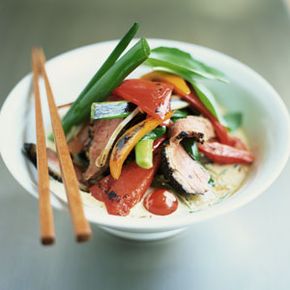An Important Balance
Perhaps the most impressive and unique trait of Thai food is the balance of its flavors. The majority of Thailand's population is Buddhist, and the religion has had a profound influence on the national cuisine. Every Thai meal seeks a harmony with its flavors, and that balance is not just limited to sweet/sour and spicy/salty combinations. The four flavors work together to balance one another out, allowing your taste buds to appreciate all the elements of the meal --- not be overridden by one or two prominent tastes.
What Makes a Thai Meal?
Advertisement
A Thai meal generally consists of soup or salad, a main course, a dip and a side or two. The portions are pretty small. The global popularity of Thai cooking has exploded over the past three decades, in part because of the forgiving nature of its recipes [source: Owen]. Most Thai dishes are relatively easy to cook, but their preparation is in no way an exact science. Measuring cups are unimportant, and recipes are more of a guide than a set of instructions. Estimations, changing ingredients -- it's all pretty much guided by your tongue. If you want to add more garlic -- add more garlic! If you feel that a recipe calls for too much fish oil -- hold back on it. Don't be afraid to tailor your cooking to suit your tastes.
Ingredients
In order to achieve the necessary balance, there are several quintessential ingredients that are found in virtually every Thai meal. They are:
- Rice: Most Thai meals include rice in at least one dish (usually jasmine, steamed or sticky white rice). However, noodles can serve as a substitute for some dishes.
- Fish Sauce: Fish sauce is the primary salty ingredient in most Thai dishes, and you'll be hard-pressed to sit down to a meal that doesn't call for it somewhere. Fish sauce has a distinctive aroma and taste that is an essential part of Thai food.
- Coconut Milk: Coconut milk has a natural, sweet flavor and is commonly found in Thai soups, desserts and seafood.
- Chili Peppers: Chili peppers make up the spicy spectrum of many Thai dishes. Ground, dried chili peppers are also an extremely common ingredient.
- Lemongrass: Lemongrass is exactly what it sounds like: a green, grasslike plant that tastes like lemon. Its thick stalk is used in many Thai dishes.
- Proteins: The protein in Thai dishes varies by region and culture, but chicken, fish, lamb, pork, eggs and duck are all common. Meats are typically shredded and only one of many ingredients in Thai dishes -- they don't make up the bulk of the entrée as they often do in the West.
If you're looking for some easy Thai recipes, try Pad Thai, Thai fried rice or Thai noodle soup. These meals are simple to make and offer a tantalizing, tasty glimpse into Thai cuisine.
Did You Know? Jasmine rice is the most common form of rice used in Thai recipes -- and it's grown exclusively in Thailand. When jasmine rice is cooked, it doesn't swell like traditional white rice; instead, it expands horizontally, becoming longer instead of fatter. It's got a unique, popcornlike smell and an unusual, nutty flavor.
Advertisement
